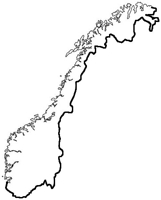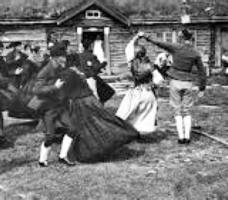
|
The Society of Folk Dance Historians (SFDH)
Historical Notes
[
Home |
About |
Encyclopedia | CLICK AN IMAGE TO ENLARGE |

|
 Rørospols (RUHR-ohs-pohls), a couple dance from eastern Norway, is as genuine a "folk dance" as can be found in all of Scandinavia, yet there no published descriptions nor printed instructions in Norwegian on how to dance it. Rørospols is one of those ethnic terpsichorean survivals known in Norwegian as "bygdedansar" ("country-local" or "village-dances"). Unlike the "turdansar" ("figure-dances") such as Reinlendar med Turar, Seksmannsril, and Åttetur, which are thouroghly documented in the official Norwegian folk dance manual, the ethnic country-dances have not passed through a "formal" stage of development, but have evolved independently among the folk, varying from district to district. Among them are Pols and Springleik (both close cousins of the Swedish Polska), Springar, Gangar, Rull, and Halling. No other Scandinavian< land has anywhere near as rich a living tradition in native dance forms as Norway.
Rørospols (RUHR-ohs-pohls), a couple dance from eastern Norway, is as genuine a "folk dance" as can be found in all of Scandinavia, yet there no published descriptions nor printed instructions in Norwegian on how to dance it. Rørospols is one of those ethnic terpsichorean survivals known in Norwegian as "bygdedansar" ("country-local" or "village-dances"). Unlike the "turdansar" ("figure-dances") such as Reinlendar med Turar, Seksmannsril, and Åttetur, which are thouroghly documented in the official Norwegian folk dance manual, the ethnic country-dances have not passed through a "formal" stage of development, but have evolved independently among the folk, varying from district to district. Among them are Pols and Springleik (both close cousins of the Swedish Polska), Springar, Gangar, Rull, and Halling. No other Scandinavian< land has anywhere near as rich a living tradition in native dance forms as Norway.
 Besides being a delightful and exhilerating dance in its own right, Rørospols is of unusual interest to the folklorist. Among the art treasures preserved in the Gripsholm castle near Stockholm, Sweden, there is a wall textile from around the year 1,500 CE, showing a fiddler, a bagpipe player, and four couples in various dance positions. It is entitled "Bonddans" ("farmer dance" or "peasant dance"). The remarkable thing is that the dancers are pictured in four sequences in which every detail corresponds to the figures of a dance found in Norway in the erea of the mining town of Røros, exactly as it is danced today! The musicians' instruments, however, are not the same as those used these days. The bagpipe (once widespread in the Northlands) has disappeared, and the fiddle pictured is quite different from the violin types now played by Scandinavian< country fiddlers. But the most intangible aspects of the dance, the dance figures themselves, are still there. Thus the Swedish tapestry indicates that this most ancient of couple dances, once common throughout northern Scandinavia (it was danced in western Sweden up to a generation ago) has managed to survive up to our day in >Norway, a span of four to five centuries without any perceptible change.
Besides being a delightful and exhilerating dance in its own right, Rørospols is of unusual interest to the folklorist. Among the art treasures preserved in the Gripsholm castle near Stockholm, Sweden, there is a wall textile from around the year 1,500 CE, showing a fiddler, a bagpipe player, and four couples in various dance positions. It is entitled "Bonddans" ("farmer dance" or "peasant dance"). The remarkable thing is that the dancers are pictured in four sequences in which every detail corresponds to the figures of a dance found in Norway in the erea of the mining town of Røros, exactly as it is danced today! The musicians' instruments, however, are not the same as those used these days. The bagpipe (once widespread in the Northlands) has disappeared, and the fiddle pictured is quite different from the violin types now played by Scandinavian< country fiddlers. But the most intangible aspects of the dance, the dance figures themselves, are still there. Thus the Swedish tapestry indicates that this most ancient of couple dances, once common throughout northern Scandinavia (it was danced in western Sweden up to a generation ago) has managed to survive up to our day in >Norway, a span of four to five centuries without any perceptible change.
The area of eastern Norway between Oslo and Trondheim is typical Pols country. There the ordinary fiddle, and not the unique Hardanger fiddle (a fiddle with eight or nine strings rather than the usual four), is the prevailing folk instrument. A driving rhythm frequently broken by subtle syncopations, and often a strange mixture of modal keys (subsets of the equal-division scales), characterize the music. Although the Pols has lost much ground the last few decades, its former popularity is attested to by the vast number of Pols tunes which have been handed down through local fiddlers.
Among Norse wedding customs was a widespread tradition of a Bride's Dance done to special music, namely Pols. The male guests (including the minister, by the way) all took turns dancing with the bride – clearly a pre-Reformation custom. (The Reformation was a schism in Western Christianity from 1517 to 1648.) The dance seems to have had two parts: a slow, dignified Polonaise-like opening, followed by a fast gyrating "round dance." Scholars point out a definite similarity to the combination of the Pavane-Gallard, so common at the time of the Renaissance (a period in European history covering the span between the 14th and 17th centuries). Quite likely the Gammal Polska of Sweden and the Sønderhoning of Denmark are remnants of this same tradition. However in all of these dances the slow fore-dance music has given away to the livlier after-dance music, leaving the introductory figures to be done to the same rhythm as the following fast turn. In most areas of Norway, the latter fast part, mostly in closed position, is the only figure still danced (for example, Springpols, which is similar to the Hambo). Only in the district of Røos has the entire "original" sequence of figures, in suite form, survived.
DOCUMENT
- Norway, a country.
From "Special Notes on Røospols" in the Idyllwild Folk Dance Workshop 1973 syllabus.
This page © 2018 by Ron Houston.
Please do not copy any part of this page without including this copyright notice.
Please do not copy small portions out of context.
Please do not copy large portions without permission from Ron Houston.